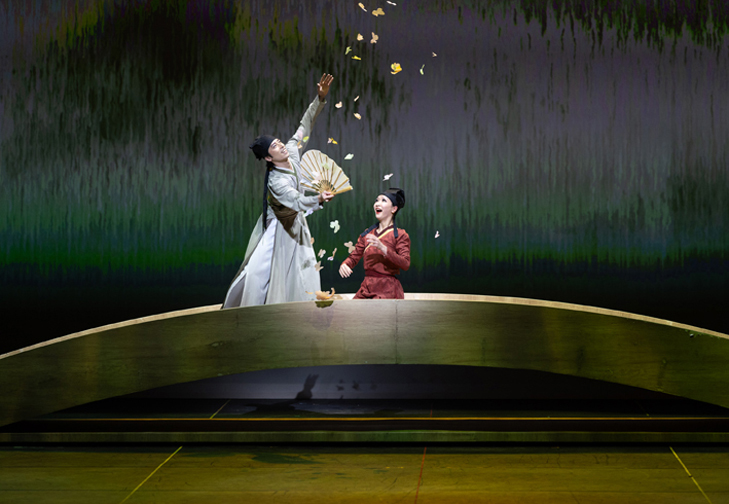By Alix Cohen
The Chinese legend The Butterfly Lovers (梁山伯与祝英台, or Liang Zhu) traces its origins to the Eastern Jin Dynasty (317–420 AD), a time marked by rigid social hierarchies and limited opportunities for women. In the 1920s, the tale was canonized as one of China’s Four Great Folktales.
The piece is often compared to Romeo and Juliet for its fusion of romantic tragedy and social critique. Today, Zhu is seen as a proto-feminist figure, challenging gender norms by wanting education and autonomy. Liang embodies Confucian ideals of loyalty, scholarship, and integrity.
Cue sweeping, romantic music.
Zhu Yingtai (Xuan Cheng) is the daughter of conservative, aristocratic parents. Dancing with her sister, a red ribbon is employed beneath skirts to train/force small steps. Cloistered and curious, she longs to attend a prestigious academy.

Zhu and her father
The young woman entreats her father (Garry Corpuz), but is intially dismissed. Zhu convinces him a well informed daughter will bring honor to the family. Girls were bred for domesticity, forbidden formal education. She dresses like a boy, keeping both sex and identity secret. On her way to the academy, Zhu revels in her first time experiencing freedom.Everything seems new. Movement fills more space as the guileless heroine expands her horizon.
Student games are light and playful, mostly danced in unison. Lines and arches form for others to pass between and beneath. Hands slap one another in camaraderie. There’s inference of high spirited fisticuffs and competition. Zhu joins, at first tentative, then wholeheartedly.
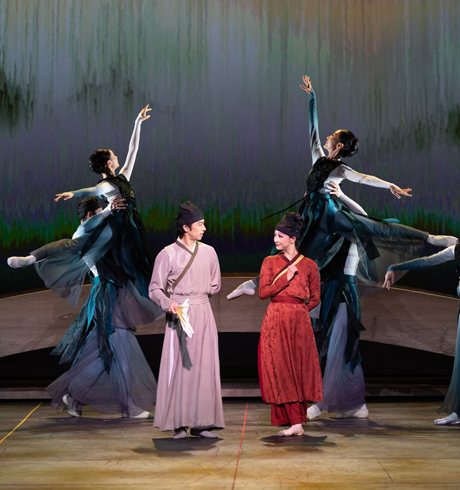
Ziang and Zhu meet
Across the grounds, Liang Shanbo (Ma Rengie) snaps a white fan. The two are drawn, dancing with one another as well as peers. On an arch bridge, his fan emits flower petals. Friendship begins. Leaps are low. Limbs extend while spinning. Arms are particularly graceful, never at rest. Dancers dip and bend, orderly, but not hard-edged.
A giant Confucius statue descends as scholars pay ceremonial homage. Watched over by a Sheng (leader), students study manuscripts employed in choreography. They move in formation perhaps meditating. Solemnity pervades. Still, Zhu and Liang are aware of one another.
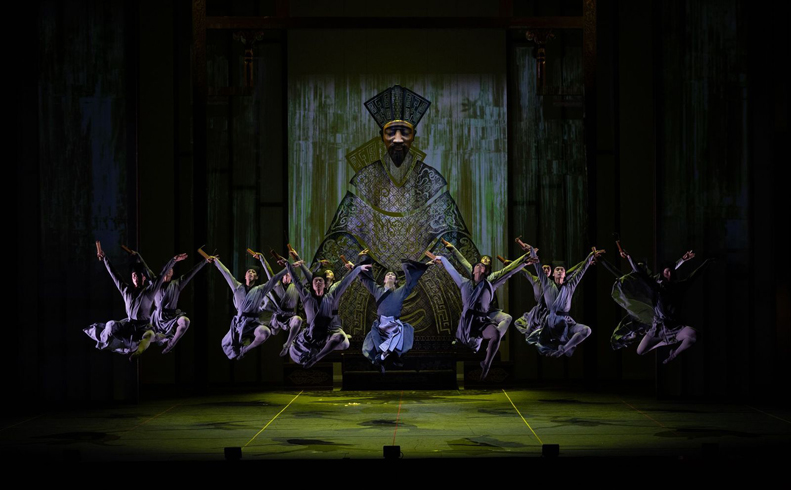
The temple
The program indicates that Liang discovers Zhu is a girl, something unclear without a decisive moment. A dormitory bed they’re to share (cleverly vertical) is met with embarrassment. When Liang eventually sleeps, Zhu climbs atop the headboard. It’s easy to assume the feelings are hers alone. She dreams of them as a couple. A lovely pas de deux is performed by Zhang Xuening
and Yonen Takano.
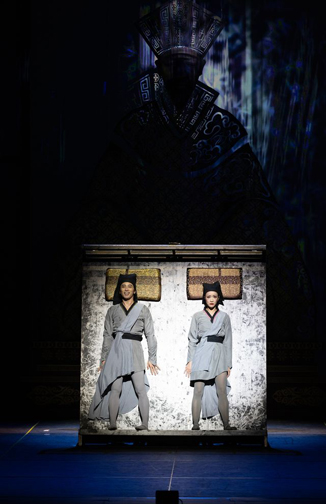
A dormitory bed
We see a class behind desks/tables on wheels. Dancers lean forward, kick back, push off. Drums and clacks penetrate music. A Master directs. Lessons? Exercise? Zhu and Liang are whirled on tabletops. One long piece of furniture is formed. Hands percussively slap the wood. Steps are sharp.
The pair meet outside and are curiously surrounded by ballerinas in white tutus, the only nod to traditional, classical ballet. What they represent is a puzzle. Zhu receives a letter, then passed to Liang. Her mother is ill, she’s required at home.
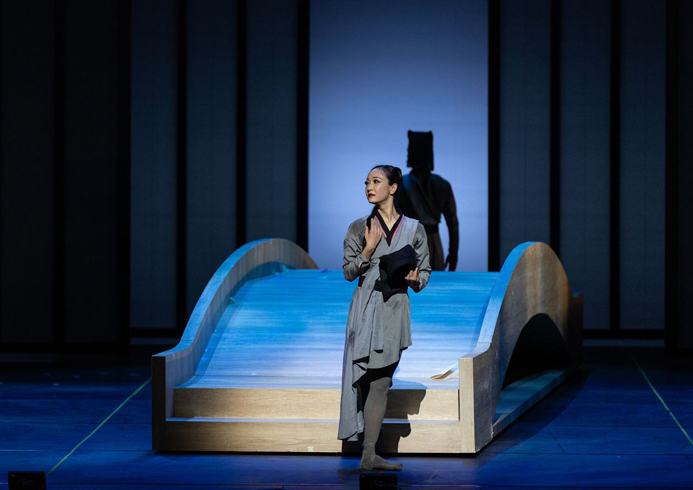
The lovers part
They say goodbye on the bridge. He lifts her in total silence before music resumes. Space is confining. She winds around his body like a snake. Every move conspires to keep them connected. The bridge revolves. Each walks to the opposite end. Zhu takes off her hat and lets her hair down.

Trapped
In Act II, the girl discovers her mother is well. She’s being married off to continue a prestigious family line. Pleading with her mother (Wang Qingxin) changes nothing. The lovers meet clandestinely and plan to elope. A beautiful pas de deux reflects longing. We glimpse a giant shadow of the matriarch.
When Liang comes for Zhu, he’s surrounded by guards. The suitor flies against them, but is beaten to death. Soldiers and music are blistering, choreography could be more so. For the first time, we hear voices- “Hey! Ha!” Liang is left in a heap. Dead, he nonetheless rises in agony, leaping, rolling, twirling, hitting his heart with a fist. In the wake of love, a silent wail is vivid.
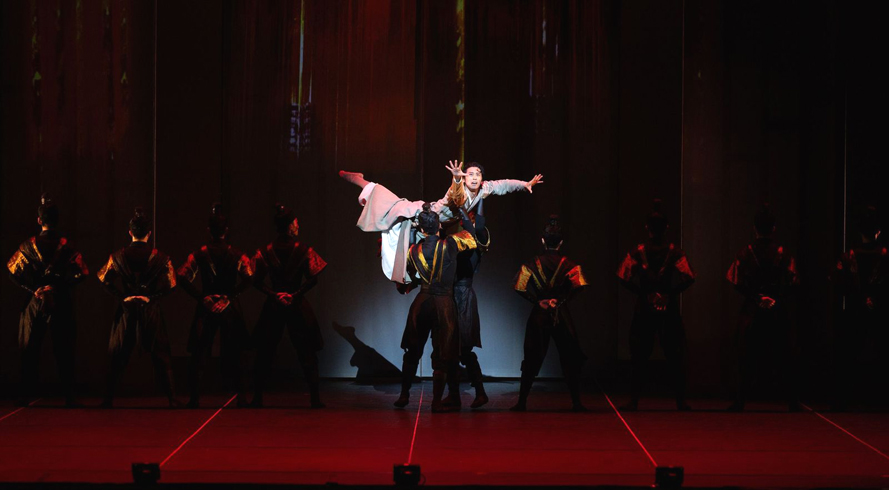
Grief stricken, Zhu seems lifeless as monther and sister prepare her for the wedding. The opulent, layered gown is white and red, with ombre effect that resembles blood stain. Ceremonial procession to her groom’s family home passes the cemetery. Zhu turns off, mounts steps, pauses and jumps into Liang’s grave in a burst of white light. The stage goes dark.
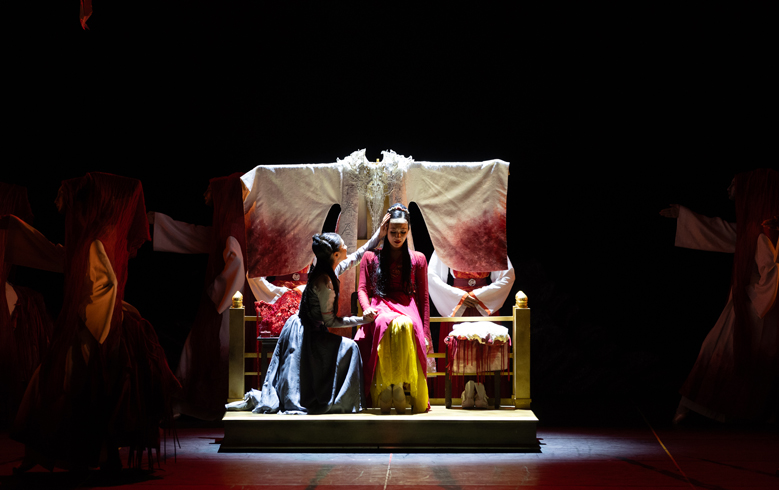
Wedding preparation
At the last, projected red leaves sway as ‘real’ petals fall from above like rain. Zhu and Liang emerge golden butterflies representing transformation, eternal love, and the soul’s freedom. Nuance of diaphanous sleeves, rather than wings is consistent with visual finesse.
The piece is dreamlike. Not a single flamboyant step appears. There are no extravagant leaps. Violence is depicted stylistically. Male dancers’ bodies are similar to those of women, here making synchronicity even more fluid. Floor work is rare.
Tian Mi’s lush score sounds western with Chinese influence, rather than vice versa. Tim Yip, Academy Award winning designer of Crouching Tiger, Hidden Dragon, offers consistently elegant, artful costumes and nuanced scenery- despite scale. Video by Yicai Wang & William Kwok and lighting by Yeung Tsz Yan consists of color and texture evoking ceramics and screens.
‘An enchantment.
Photos by Rosalie O’Connor
Hong Kong Ballet: The Butterfly Lovers – New York Premiere
Artistic Director- Septime Webre
Concept and Choreography- Hu Song Wei Ricky
Music- Tian Mi (Inspired by He Zhanhao and Chen Gang’s The Butterfly Lovers Violin Concerto
Music & Orchestral Arrangement – Zhou Chuhang, Luo Geng, Zhang Qun, Zhang Qiandan, Zhang Boning
David H. Koch Theater at Lincoln Center August 22, 2025

